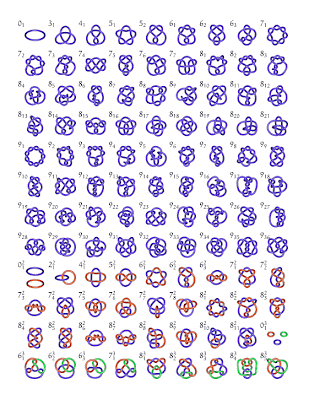"In 1867 after observing Scottish physicist Peter Tait's experiments involving smoke rings, Thomson came to the idea that atoms were knots of swirling vortices in the æther. Chemical elements would thus correspond to knots and links. Tait's experiments were inspired by a paper of Helmholtz's on vortex-rings in incompressible fluids. Thomson and Tait believed that an understanding and classification of all possible knots would explain why atoms absorb and emit light at only the discrete wavelengths that they do. " (http://en.wikipedia.org/wiki/History_of_knot_theory)
Knot & Vortex theories were aligned with Aether theories, and the difficulty was how to add values to calculations when you don't know what it is and how it behaves, you need to be able to measure it. Multiple Aether theories existed but not one was applicable for all the different laws of nature, and opposition would arise.
In 1887 a first blow came when the Michelson–Morley experiment failed to provide any measurements of Aether wind. A second blow came in 1900 when Max Planck postulated, that electromagnetic energy could be emitted only in quantized form, Einstein took a look at this fact, and turned light that was originally thought of as only a wave, into a particle (photon) that could move through a vacuum. A final blow came in 1905 when Einstein (again), published his papers on Special Relativity, using light as a constant, and postulating that space can change. The unique fact of this way of looking at things is that he could measure all of the physically observable consequences of Lorentz ether theory (the most advanced Aether theory of that time), without the need to postulate an unobservable entity (Aether). This revolutionized science because it made things easy and modern. As of then Aether was seen as a pagan thing and defenders were boohooed, but perhaps this revolution might have thrown out the baby with the bathwater, being Vortex & Knot Theory, and of course Aether itself.
Edit: The scientific community has drifted away from the idea of a medium (aether), and considered it wrong, but when looking at the history of physics you might want to think again. Albert Einstein writes in the end of his book - Über die spezielle und die allgemeine Relativitätstheorie (link) - that his theory does not contradict the theory of an Aether at rest:
"Betreffend den Versuch von Michelson und Morley zeigte H. A. Lorentz, daß dessen Ergebnis wenigstens nicht im Widerspruch sei mit der Theorie des ruhenden Äthers."
While some like to focus on the 'Michelson-Morley experiment':
"Its results are generally considered to be the first strong evidence against the theory of a luminiferous aether and in favor of special relativity (SR). The most immediate effect at the time was to put an end to Lord Kelvin's Vortex theory, which said that atoms were vortices in the aether." (http://en.wikipedia.org/wiki/Michelson–Morley_experiment)
The difference in the 2 statements is; in the first Einstein focusses on the fact that SR is not against Aether, while the second focusses on the fact that SR is against Aether. The difference is Aether at rest vs. luminiferous Aether.
-
At the center of my knot-model there is a Trefoil-knot (Proton) with 3 Loops (Quarks), connected via a string to the Torus (Electron), all rotating and moving through a Dynamic Foam (SpaceTime).
Large interconnected-structures form heavier Atoms with Shells.
A figure 8 Knot (Photon) is like a helicopter,
shooting from Torus (Electron) to Torus (Electron): O = OO => O
Check the top-view where the rotating ((8)) is like a torpedo with propellor shooting forward, or at side-view where it is like a stingray steadily swimming forward.
In essence this idea of having knots emerge within a medium is at the opposite side of the Millennium Run. They zoom-out towards the large networks, while I'm zooming into the foam-ish Aether wherein small self-regulating networks and knots emerge.








